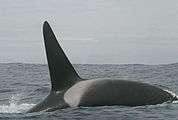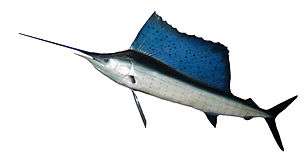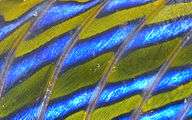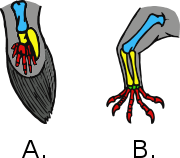Dorsal fin

A dorsal fin is a fin located on the backs of various unrelated marine and freshwater vertebrates, including most fish, cetaceans (whales, dolphins, and porpoises), and the (extinct) ichthyosaurs. Depending on the species, an animal may have one or two of them.
Wildlife biologists often use the distinctive nicks and wear patterns which develop on the dorsal fins of large cetaceans to identify individuals in the field.
The bony or cartilaginous bones that support the base of the dorsal fin in fish are called pterygiophores.
Functions
The main purpose of the dorsal fin is to stabilize the animal against rolling and to assist in sudden turns. Some species have further adapted their dorsal fins to other uses. The sunfish uses the dorsal fin (and the anal fin) for propulsion. In anglerfish, the anterior of the dorsal fin is modified into a biological equivalent to a fishing pole and a lure known as illicium or esca. Many catfish can lock the leading ray of the dorsal fin in an extended position to discourage predation or to wedge themselves into a crevice. Some animals have developed dorsal fins with protective functions, such as spines or venom. For example, both the spiny dogfish and the Port Jackson shark have spines in their dorsal fins which are capable of secreting poison.
Billfish have prominent dorsal fins. Like tuna, mackerel and other scombroids, billfish streamline themselves by retracting their dorsal fins into a groove in their body when they swim.[1] The shape, size, position and colour of the dorsal fin varies with the type of billfish, and can be a simple way to identify a billfish species. For example, the white marlin has a dorsal fin with a curved front edge and is covered with black spots. The huge dorsal fin, or sail, of the sailfish is kept retracted most of the time. Sailfish raise them if they want to herd a school of small fish, and also after periods of high activity, presumably to cool down.[1][2]
-

Dorsal fin of an orca
-

Large retractable dorsal fin of the Indo-Pacific sailfish
-

Closeup of the dorsal fin of a common dragonet
- ^ Lingham‐Soliar T (2005) "Dorsal fin in the white shark, Carcharodon carcharias: A dynamic stabilizer for fast swimming" Journal of Morphology, 263 (1): 1–11. doi:10.1002/jmor.10207 pdf
See also
| Look up dorsal in Wiktionary, the free dictionary. |
Notes
- 1 2 Aquatic Life of the World pp. 332–333, Marshall Cavendish Corporation, 2000. ISBN 9780761471707.
- ↑ Dement J Species Spotlight: Atlantic Sailfish (Istiophorus albicans) littoralsociety.org. Retrieved 1 April 2012.
.jpg)

